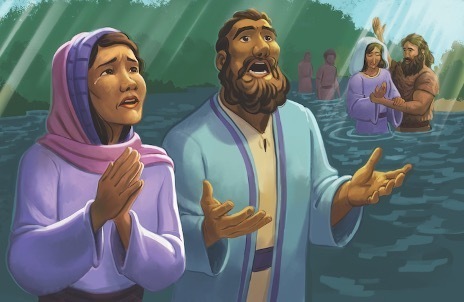The popularity of true crime shows reveals something interesting about people. Whether it be a television show, a streaming series, or a podcast, audiences love a good thrilling episode that takes you on a journey from the mind-captivating details of a crime, through the exploration of the evidence, to the identification of a suspect, and concluding with the resolution of who did it, how they did it, and whether or not they are found guilty.
One shared characteristic between each story is this: there is no case if there is no evidence. Evidence is everything to making a determination about a suspect and building a case.
When it comes to repentance, we understand from this biblical word and its contexts throughout Scripture that it requires both an internal and external turning from sin and movement toward God. Repentance is something that takes place inside someone’s heart and mind while also bringing visible evidence of sorrow about sin and the desire to change.
Matthew 3 contains a subtle but direct indication that true repentance always produces evidence of change. Matthew 3:10 says, “Therefore, every tree that doesn’t produce good fruit will be cut down and thrown into the fire.”
Just two verses earlier, Matthew warned the Pharisees and Sadducees to produce fruit consistent with repentance. And all of this seems to indicate that there is something that happens in the life of someone who is repentant that is visible to those around him. Where there is true repentance, there is always evidence.
We cannot see the thoughts and intentions of the heart; however, we can look for evidence of repentance. What begins in the heart will certainly impact the life of the believer. When this happens, it becomes visible that change has occurred.
Take time this week to ask the hard question of whether or not there is fruit, or evidence, of repentance in your own life. Has the change of heart that repentance begins led to visible change in your life? If so, find great confidence in the grace of God that led you to repentance. And if not, ask the Lord to help you understand why.
Check out The Gospel Project At Home for resources designed to help you lead a family worship experience as well as suggestions for morning and evening prayer times and family activities. Access this week's video and lesson here.
FAMILY TALKING POINTS
CHRIST CONNECTION
This is the big idea of how this week’s Bible story points to Jesus.
- Babies & Toddlers: John told people to repent—to turn away from their sins—and turn to Jesus.
- Younger Preschool: John told people to repent—turn away from their sins—and turn to Jesus. When we trust in Jesus, Jesus changes the way we think and act to help us love God and people.
- Older Preschool: John called people to repent—to turn away from their sins and turn to Jesus. When we trust in Jesus to rescue us from sin and death, Jesus changes the way we think and act to help us love God and people.
- Kids: John called people to repent. When we realize that our sin deserves God’s punishment and trust in Jesus to save us, we can turn from our sins and live for Jesus. Jesus changes our hearts so we can love God and people.
BIG PICTURE QUESTION & ANSWER
This is an important biblical truth that your child will encounter each week of this unit.
- Younger Preschool: What is repentance? Repentance is choosing to stop making wrong choices and choosing Jesus.
- Older Preschool: What is repentance? Repentance is turning away from sin and turning to Jesus.
- Kids: What is repentance? Repentance is turning away from sin and turning to Jesus.
KEY PASSAGE
This is a Bible verse that relates to what your child will encounter each week of this unit.
- Babies & Toddlers: Turn away from your wrong choices. Acts 3:19
- Younger Preschool: Turn away from your wrong choices. Acts 3:19
- Older Preschool: “Therefore repent and turn back, so that your sins may be wiped out.” Acts 3:19
- Kids: “Therefore repent and turn back, so that your sins may be wiped out.” Acts 3:19
** Next week: Jonah Warned of God’s Judgment (Jonah)
